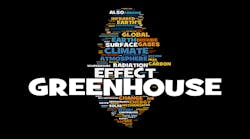Pushed by an Executive Order of the Obama Administration that calls for a 40% reduction in greenhouse gas (GHG) emissions over the next 10 years (from 2008 levels), several suppliers have stepped up to the plate and made clear that they are going to comply.
In fact this group of suppliers, who each do more than $1 billion a year in business with the government and account for $45 billion in Federal contract spending, have committed to a total GHG reduction of 5 million metric tons between 2008 and 2020.
Lest you think that the government has no skin in the game, here is part of what they have pledged to do. With a footprint that includes 650,000 fleet vehicles, they will reduce per-mile GHG emissions by 30% from 2014 levels by 2025. The government has also promised to increase the percentage of zero emission and plug-in hybrid vehicles in its fleets.
So the total effect from the government and the suppliers are a reduction of GHG emissions by 26 million metric tons by 2025. (Translated into logistics terms, this is the equivalent of nearly 5.5 million cars coming off the road for a year.)
And these pledges will be tracked publicly since the total Federal contracts to all major suppliers, not just those mentioned above, represents 40% of all Federal contracts, translating into $187 billion in spending.
Here's a look at some of the specific commitments:
ADS Inc.
One of the largest providers of operational equipment, procurement and logistics solutions to the Department of Defense, ADS says it will expand its environmentally-friendly product offerings and will actively begin promoting green technologies such as flex-fuel and hybrid power generation, micro grid systems, solar and wind fuel systems. Furthermore, ADS plans to benchmark its internal energy and fuel consumption and put forth a reduction plan in 2015.
IBM
The company will reduce CO2 emissions by 35% by year-end 2020 against base year 2005. This represents an additional 20% reduction from year-end 2012 to year-end 2020 over the reductions achieved from 2005 to 2012. IBM will also procure electricity from renewable sources for 20% of its annual electricity consumption by 2020, and will contract over 800,000 megawatt-hours per year of renewable electricity.
General Electric
By the end of 2013, GE had reduced its global GHG emissions by 34% from 2004 and water use by 45% from 2006. The company also announced 2020 commitments to invest a cumulative $25 billion in R&D and reduce water and greenhouse gas emissions by 20% from a 2011 baseline.
Honeywell
Honeywell exceeded its first public goal to reduce GHGs by more than 30% from a 2004 baseline in 2011, and then achieved an additional 15% per dollar of revenue reduction from 2011 levels by 2014. The company's facilities have implemented more than 2,100 energy efficiency projects, including building automation/controls, lighting, and mechanical upgrades since 2010.
Northrop Grumman
Goals for 2020 are: to reduce absolute GHG emissions 30% from 2010 levels; to reduce water consumption by 20% from 2014 levels; and to achieve a 70% solid waste diversion rate. As of 2013, the company had reduced its GHG emissions intensity by 26.5% relative to 2008 levels.
While suppliers are willing to go along with the new rules, the truckers aren't so sure about emission standards that some states are trying to set. At the end of last month the American Trucking Associations joined with the American Fuel & Petrochemical Manufacturers and the Consumer Energy Alliance in suing the state of Oregon to block the state's low carbon fuel standards.
"The Oregon program is set up to give a big boost to Oregon's small biofuel industry, without reducing net greenhouse gas emissions, and at the expense of higher fuel costs for everyone," says Glen Kedzie, ATA's vice president for energy and environmental affairs. "Unfortunately for Oregon, the Constitution doesn't allow states to set up these kinds of trade barriers in order to promote in-state businesses, nor does it allow Oregon to regulate how fuel is produced in other states.
"A similar standard implemented in neighboring California is projected to add roughly $1.89 per gallon wholesale by 2020," Kedzie adds, citing a California Trucking Association study.
The debate about how to achieve lower emission standards will continue as federal pressure is also sure to continue.



